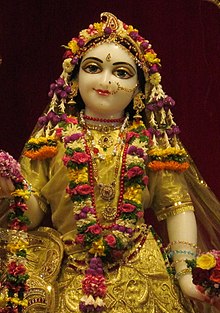
Back رادها Arabic رادها ARZ ৰাধা Assamese Radha BCL राधा Bihari রাধা Bengali/Bangla Radha Catalan Radha German Radhao Esperanto Radha Spanish
| Translations of राधा (Rādhā) | |
|---|---|
| Sanskrit | राधा (Rādhā) |
| Bengali | রাধা (Rādhā) |
| Hindi | राधा (Rādhā) |
| Kannada | ರಾಧಾ (Rādhā) |
| Malayalam | രാധ (Rādhā) |
| Marathi | राधा (Rādhā) |
| Odia | ରାଧା (Rādhā) |
| Telugu | రాధ (Rādhā) |
| Gujarati | રાધા (Rādhā) |
| Glossary of Hinduism terms | |
| Part of a series on |
| Vaishnavism |
|---|
 |
Radha (Sanskrit: राधा, IAST: Rādhā), also called Radhika, is a Hindu goddess and the chief consort of the god Krishna. She is the goddess of love, tenderness, compassion, and devotion. In scriptures, Radha is mentioned as the avatar of Lakshmi[12][13] and also as the Mūlaprakriti, the Supreme goddess, who is the feminine counterpart and internal potency (hladini shakti) of Krishna.[1][14][15][16][17] Radha accompanies Krishna in all his incarnations.[18][19] Radha's birthday is celebrated every year on the occasion of Radhashtami.[20][21]
In relation with Krishna, Radha has dual representation—the lover consort as well as his married consort. Traditions like Nimbarka Sampradaya worship Radha as the eternal consort and wedded wife of Krishna.[22][23][24][25] In contrast, traditions like Gaudiya Vaishnavism revere her as Krishna's lover and the divine consort.[26][24]
In Radha Vallabh Sampradaya and Haridasi Sampradaya, only Radha is worshipped as the Supreme being.[27] Elsewhere, she is venerated with Krishna as his principal consort in Nimbarka Sampradaya, Pushtimarg, Mahanam Sampradaya, Swaminarayan Sampradaya, Vaishnava-Sahajiya, Manipuri Vaishnavism, and Gaudiya Vaishnavism movements linked to Chaitanya Mahaprabhu.[28]
Radha is described as the chief of Braj Gopis (milkmaids of Braj).[24] She has inspired numerous literary works, and her Raslila dance with Krishna has inspired many types of performance arts.[29][30][26][31]
- ^ a b Diana Dimitrova (2018). Divinizing in South Asian Traditions. Routledge. ISBN 978-0-8153-5781-0.
Radha is mentioned as the personification of the Mūlaprakriti, the "Root nature", that original seed from which all material forms evolved
- ^ Vemsani 2016, p. 222: "The Devibhagvata purana and Padma purana describe Radha's cosmological role as Prakriti and Shakti"
- ^ David R. Kinsley (1986). Hindu Goddesses. Motilala Banarsidass. p. 91. ISBN 978-81-208-0394-7.
Radha is called mother of the world and Krishna father of the world
- ^ Prafulla Kumar Mohanty (2003). "Mask and Creative Symbolisation in Contemporary Oriya Literature: Krishna, Radha and Ahalya". Indian Literature. 2 (214). Sahitya Akademi: 182. JSTOR 23341400.
Radha is the power of joy, the Hladini shakti of Krishna
- ^ Guy Beck (2005). Alternative Krishnas: Regional and Vernacular Variations on a Hindu Deity. Suny Press. pp. 64–81. ISBN 978-0-7914-6415-1.
Radha is goddess of love to Krishna
- ^ Edwin Francis Bryant (2007). Krishna : A Sourcebook. Suny Press. p. 443. ISBN 978-0-19-803400-1.
Significant manifestation of feminine in Vaishnavism..the supreme goddess Radha, the favourite Gopi of Krishna
- ^ Roy C Amore (1976). "Religion in India". Journal of the American Academy of Religion. 14 (2): 366.
Radha as Prakriti comes to supreme prominence, assuming epithets of transcendence - Brahmasvarupa, Nirguna...
- ^ Ludo Rocher (1988). "The Purāṇas (A History of Indian Literature". Bulletin of the School of Oriental and African Studies. 51 (2): 355.
- ^ Vemsani 2016, pp. 222–223.
- ^ Ved Vyaas. Brahma Vaivarta Purana. Gita Press, Gorakhpur. p. 297.
- ^ Menzies 2006, p. 54.
- ^ Jones, Naamleela Free (2015). "From Gods To Gamers: The Manifestation of the Avatar Throughout Religious History and Postmodern Culture". Berkeley Undergraduate Journal. 28 (2): 8. doi:10.5070/B3282028582.
- ^ Gokhale, Namita; Lal, Malashri (10 December 2018). Finding Radha: The Quest for Love. Penguin Random House India Private Limited. ISBN 978-93-5305-361-1.
Like Sita, Radha is also a manifestation of Lakshmi.
- ^ Cite error: The named reference
:4was invoked but never defined (see the help page). - ^ Bryant, Edwin Francis (2007). Krishna: A Sourcebook. Oxford University Press. p. 551. ISBN 978-0-19-514892-3.
- ^ Kar, Nishamani (2001). "Sriradha: A Study". Indian Literature. 45 (2 (202)): 184–192. ISSN 0019-5804. JSTOR 23344745.
- ^ Cite error: The named reference
:5was invoked but never defined (see the help page). - ^ Vyasadeva (18 June 2015). Narada Pancaratra Part 2. p. 448.
- ^ Farquhar, J. N. (1926). "The Narada Pancharatra". Journal of the Royal Asiatic Society of Great Britain and Ireland (3): 492–495. ISSN 0035-869X. JSTOR 25221011.
- ^ Vemsani 2016, p. 223.
- ^ Mohanty, Prafulla Kumar (2003). "Mask and Creative Symbolisation in Contemporary Oriya Literature : Krishna, Radha and Ahalya". Indian Literature. 47 (2 (214)): 181–189. ISSN 0019-5804. JSTOR 23341400.
- ^ Farquhar, J. N. (1926). "The Narada Pancharatra". Journal of the Royal Asiatic Society of Great Britain and Ireland (3): 492–495. ISSN 0035-869X. JSTOR 25221011.
- ^ Bhattacharya, Sunil Kumar (1996). Krishna-cult in Indian Art. M.D. Publications Pvt. Ltd. p. 13. ISBN 978-81-7533-001-6.
..Radha is the eternal consort and wedded wife of Krishna, who lives forever with him in Goloka.
- ^ a b c Lochtefeld 2002, p. 542.
- ^ Jones & Ryan 2007, p. 341, Radha.
- ^ a b "Radha". Encyclopædia Britannica Online. Retrieved 13 December 2020.
- ^ White 1977; Snell 1991, chapter1; Rosenstein 1998; Beck 2005; Vemsani 2016, p. 222.
- ^ Hawley & Wulff 1982, pp. xiii–xviii; Dalal 2010, pp. 321–322; Hayes 2005, pp. 19–32; Vemsani 2016, p. 221.
- ^ Archer 2004.
- ^ Hawley & Wulff 1982, pp. xiii–xviii.
- ^ Pintchman 2005, pp. 46–47.
© MMXXIII Rich X Search. We shall prevail. All rights reserved. Rich X Search
